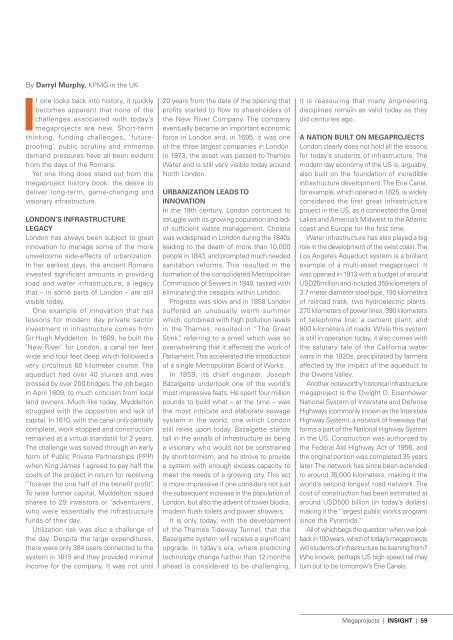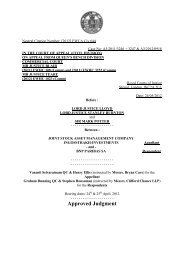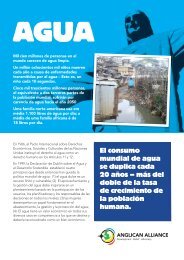Megaprojects - KPMG
Megaprojects - KPMG
Megaprojects - KPMG
Create successful ePaper yourself
Turn your PDF publications into a flip-book with our unique Google optimized e-Paper software.
By Darryl Murphy, <strong>KPMG</strong> in the UK<br />
If one looks back into history, it quickly<br />
becomes apparent that none of the<br />
challenges associated with today’s<br />
megaprojects are new. Short-term<br />
thinking, funding challenges, ‘futureproofing’,<br />
public scrutiny and immense<br />
demand pressures have all been evident<br />
from the days of the Romans.<br />
Yet one thing does stand out from the<br />
megaproject history book: the desire to<br />
deliver long-term, game-changing and<br />
visionary infrastructure.<br />
London’s infrastructure<br />
LEGACy<br />
London has always been subject to great<br />
innovation to manage some of the more<br />
unwelcome side-effects of urbanization.<br />
In her earliest days, the ancient Romans<br />
invested significant amounts in providing<br />
road and water infrastructure, a legacy<br />
that – in some parts of London – are still<br />
visible today.<br />
One example of innovation that has<br />
lessons for modern day private sector<br />
investment in infrastructure comes from<br />
Sir Hugh Myddelton. In 1609, he built the<br />
‘New River’ for London, a canal ten feet<br />
wide and four feet deep which followed a<br />
very circuitous 60 kilometer course. The<br />
aqueduct had over 40 sluices and was<br />
crossed by over 200 bridges. The job began<br />
in April 1609, to much criticism from local<br />
land owners. Much like today, Myddelton<br />
struggled with the opposition and lack of<br />
capital. In 1610, with the canal only partially<br />
complete, work stopped and construction<br />
remained at a virtual standstill for 2 years.<br />
The challenge was solved through an early<br />
form of Public Private Partnerships (PPP)<br />
when King James I agreed to pay half the<br />
costs of the project in return for receiving<br />
“forever the one half of the benefit profit”.<br />
To raise further capital, Myddelton issued<br />
shares to 29 investors or ‘adventurers’,<br />
who were essentially the infrastructure<br />
funds of their day.<br />
Utilization risk was also a challenge of<br />
the day. Despite the large expenditures,<br />
there were only 384 users connected to the<br />
system in 1615 and they provided minimal<br />
income for the company. It was not until<br />
20 years from the date of the opening that<br />
profits started to flow to shareholders of<br />
the New River Company. The company<br />
eventually became an important economic<br />
force in London and, in 1695, it was one<br />
of the three largest companies in London.<br />
In 1973, the asset was passed to Thames<br />
Water and is still very visible today around<br />
North London.<br />
Urbanization leads to<br />
innovATIon<br />
In the 19th century, London continued to<br />
struggle with its growing population and lack<br />
of sufficient waste management. Cholera<br />
was widespread in London during the 1840s<br />
leading to the death of more than 10,000<br />
people in 1843, and prompted much needed<br />
sanitation reforms. This resulted in the<br />
formation of the consolidated Metropolitan<br />
Commission of Sewers in 1848, tasked with<br />
eliminating the cesspits within London.<br />
Progress was slow and in 1858 London<br />
suffered an unusually warm summer<br />
which, combined with high pollution levels<br />
in the Thames, resulted in “The Great<br />
Stink”, referring to a smell which was so<br />
overwhelming that it affected the work of<br />
Parliament. This accelerated the introduction<br />
of a single Metropolitan Board of Works.<br />
In 1859, its chief engineer, Joseph<br />
Bazalgette undertook one of the world’s<br />
most impressive feats. He spent four million<br />
pounds to build what – at the time – was<br />
the most intricate and elaborate sewage<br />
system in the world, one which London<br />
still relies upon today. Bazalgette stands<br />
tall in the annals of infrastructure as being<br />
a visionary who would not be constrained<br />
by short-termism, and he strove to provide<br />
a system with enough excess capacity to<br />
meet the needs of a growing city. This act<br />
is more impressive if one considers not just<br />
the subsequent increase in the population of<br />
London, but also the advent of tower blocks,<br />
modern flush toilets and power showers.<br />
It is only today, with the development<br />
of the Thames Tideway Tunnel, that the<br />
Bazelgatte system will receive a significant<br />
upgrade. In today’s era, where predicting<br />
technology change further than 12 months<br />
ahead is considered to be challenging,<br />
it is reassuring that many engineering<br />
disciplines remain as valid today as they<br />
did centuries ago.<br />
A nation built on megaprojects<br />
London clearly does not hold all the lessons<br />
for today’s students of infrastructure. The<br />
modern day economy of the US is, arguably,<br />
also built on the foundation of incredible<br />
infrastructure development. The Erie Canal,<br />
for example, which opened in 1825, is widely<br />
considered the first great infrastructure<br />
project in the US, as it connected the Great<br />
Lakes and America’s Midwest to the Atlantic<br />
coast and Europe for the first time.<br />
Water infrastructure has also played a big<br />
role in the development of the west coast. The<br />
Los Angeles Aqueduct system is a brilliant<br />
example of a multi-asset megaproject. It<br />
was opened in 1913 with a budget of around<br />
USD25million and included 359 kilometers of<br />
3.7 meter diameter steel pipe, 190 kilometers<br />
of railroad track, two hydroelectric plants,<br />
270 kilometers of power lines, 390 kilometers<br />
of telephone line, a cement plant, and<br />
800 kilometers of roads. While this system<br />
is still in operation today, it also comes with<br />
the salutary tale of the California water<br />
wars in the 1920s, precipitated by farmers<br />
affected by the impact of the aqueduct to<br />
the Owens Valley.<br />
Another noteworthy historical infrastructure<br />
megaproject is the Dwight D. Eisenhower<br />
National System of Interstate and Defense<br />
Highways (commonly known as the Interstate<br />
Highway System), a network of freeways that<br />
forms a part of the National Highway System<br />
in the US. Construction was authorized by<br />
the Federal Aid Highway Act of 1956, and<br />
the original portion was completed 35 years<br />
later. The network has since been extended<br />
to around 76,000 kilometers, making it the<br />
world’s second longest road network. The<br />
cost of construction has been estimated at<br />
around USD500 billion (in today’s dollars)<br />
making it the “largest public works program<br />
since the Pyramids.”<br />
All of which begs the question: when we look<br />
back in 100 years, which of today’s megaprojects<br />
will students of infrastructure be learning from<br />
Who knows, perhaps US high speed rail may<br />
turn out to be tomorrow’s Erie Canals.<br />
<strong>Megaprojects</strong> | INSIGHT | 59





![[2012] UKUT 399 (TCC)](https://img.yumpu.com/51352289/1/184x260/2012-ukut-399-tcc.jpg?quality=85)





![Neutral Citation Number: [2009] EWHC 3198 (Ch) Case No: CH ...](https://img.yumpu.com/50120201/1/184x260/neutral-citation-number-2009-ewhc-3198-ch-case-no-ch-.jpg?quality=85)





